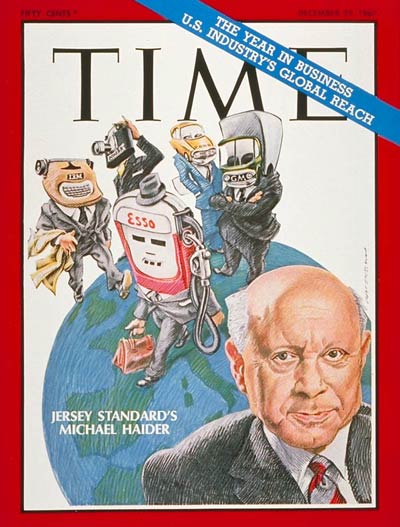
Milestone moments do not a year make. Often, it’s the smaller news stories that add up, gradually, to big history. With that in mind, in 2017 TIME History will revisit the entire year of 1967, week by week, as it was reported in the pages of TIME. Catch up on last week’s installment here.
This week’s issue, like many year-end issues in this period, took a look back at the year in business and economics, focusing on the internationalization of U.S. companies. Though not everyone was happy about the trend — the U.S. government as well as European leaders had condemned it as ultimately damaging to the global economy — this week’s cover story made the argument that globalization could not be stopped.
As the story explained, U.S. companies were rising to dominance around the globe:
Last year American firms invested $10.2 billion, or about 14% of all their capital spending on plant and equipment, in ventures outside the U.S. This rising annual amount brought their total overseas ante to $64.8 billion, more than the gross national product of many a nation, and eight times the amount foreign businessmen have invested in the U.S. in the 191 years of the Republic. Americans now control 80% of Europe’s computer business, 90% of the microcircuit industry, 40% of its automaking, and sizable shares of chemicals, farm machinery and oil. In Britain, U.S. companies own half of all modern industry, employ one of every 17 British workingmen, manufacture 10% of all British goods for home consumption or export. U.S. firms also squeeze out twice as much profit from invested capital as their British competitors. Of this, they ship $225 million a year home, reinvest the rest for the long term abroad.
All this has come about with astonishing rapidity. In 1945, with World War II over and international business reviving, U.S. companies had only a modest $8.4 billion invested around the world. By 1958, this had grown to $27.4 billion. With last year’s increase, U.S. private investment abroad has octupled in 20 years. And the move abroad is undiminished, if only because the market is there. Explains Rubberman Raymond C. Firestone: “Sometime in 1968, the number of motor vehicles in use in other nations will outnumber those in the U.S. for the first time. We want to put tires on those vehicles.”
Why was this happening? One theory was that, even as postwar Europe embraced the Common Market theory and encouraged trade between nations, European businesses were not fully prepared to function in that much larger market. American businesses, by contrast, were well used to operating in continent-spanning contexts.
And what did that mean for the year ahead? Though 1967 had, despite international gains, seen a “mini-recession” in the U.S., economists predicted that the year 1968 would be “a good one — better than 1967.”
1967’s Person of the Year: Though TIME’s editors have always been responsible for making the ultimate decision as to who would be the Person of the Year, that has never stopped readers from writing in with suggestions. Those ideas appearing in this week’s Letters section run the gamut from “Wretched Humanity” to Timothy Leary. (Spoiler alert: It went to LBJ.)
Drink up: In the essay this week, TIME took a look at the state of the American drinker. December was the drinkingest month of the year, and in 1967 Americans were expected to spend $1.1 billion ($8 billion in today’s dollars) on booze, with the year’s total consumption coming to 4 billion gallons of alcohol. (At the time, one in every 16 Americans drank enough to officially qualify as a problem drinker.) Though that sounds like a lot, the magazine’s stance on the matter was rather optimistic. Compared to past stats, more of that drinking was taking place in the home and consisted of wine, and it seemed that the nation — which had often veered wildly toward puritan teetotaling — was starting to take a more moderate, “commonsensical” attitude toward alcohol. Case in point: “The alcoholic is a product of any drinking culture,” the piece noted, “but America is beginning to realize that he is a sick man rather than a sinner.”
Out with the old: As 1967 came to a close, so did a media era. With the announcement that Universal News would cease distribution, the age of movie-theater newsreels came to an end, the old format displaced by television news. As the magazine noted, “managers find it more profitable to schedule an intermission instead of a newsreel and give patrons a chance to buy popcorn and 20¢ candy bars.”
In with the new: Another realm in which video technology was making a difference was the world of criminal justice, as a Topeka, Kans., trial saw the second instance in U.S. history in which a judge watched a video in court in the course of a trial.
Great vintage ad: The guy in this Goodyear Chemicals ad looks like a character from a Wes Anderson movie.
Revisit the year: Click here to see the whole of this series revisiting the year 1967 through the pages of TIME.
More Must-Reads from TIME
- Donald Trump Is TIME's 2024 Person of the Year
- Why We Chose Trump as Person of the Year
- Is Intermittent Fasting Good or Bad for You?
- The 100 Must-Read Books of 2024
- The 20 Best Christmas TV Episodes
- Column: If Optimism Feels Ridiculous Now, Try Hope
- The Future of Climate Action Is Trade Policy
- Merle Bombardieri Is Helping People Make the Baby Decision
Write to Lily Rothman at lily.rothman@time.com